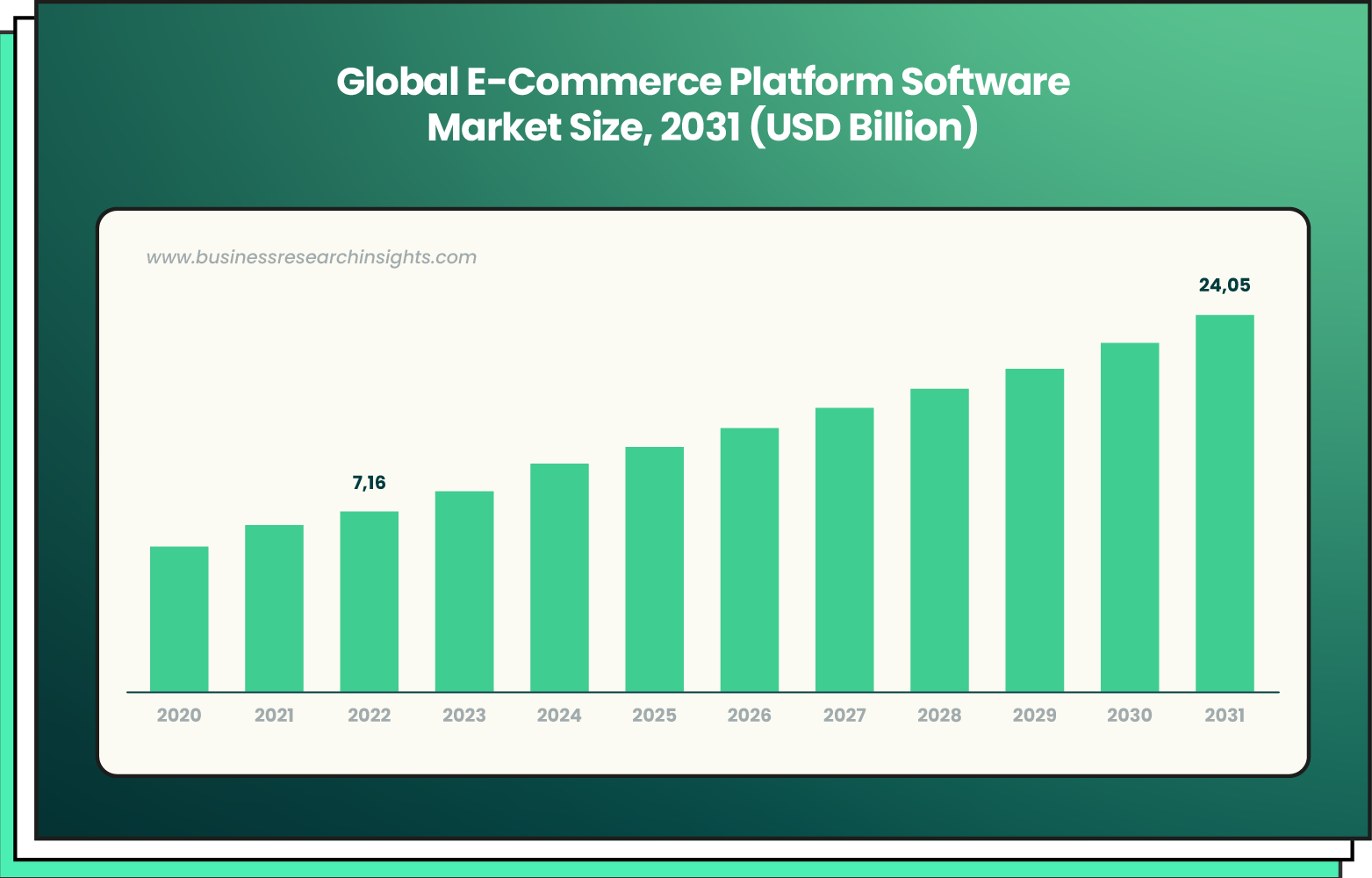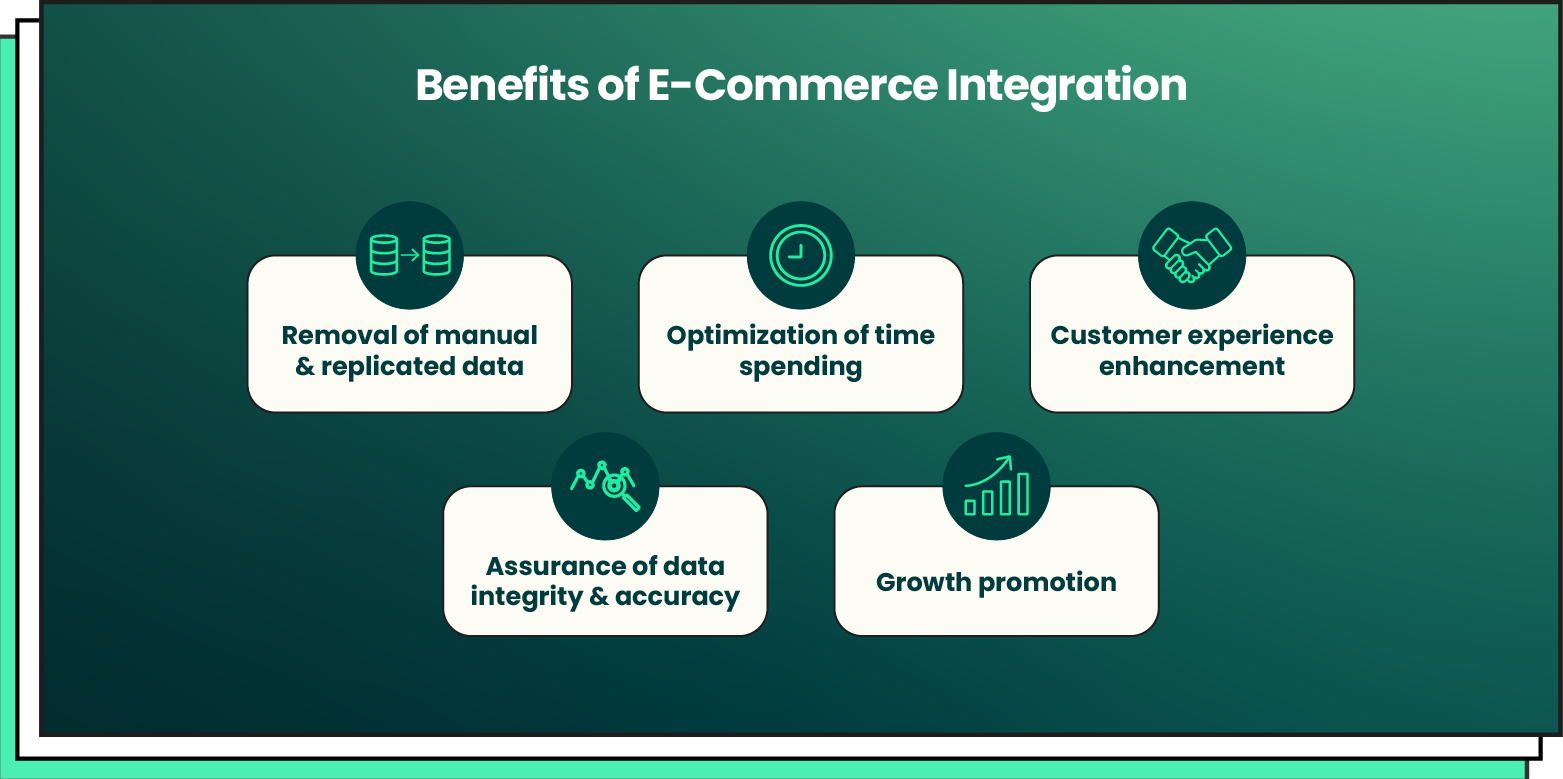According to Business Research Insights, in 2023, the global e-commerce platform market size will exceed $7 billion, with projections to surpass $24 billion by 2031. What’s more, the growth rate is going to be 12.4%. Sounds fantastic, don’t you think?

But why is the e-commerce platform industry growth so tremendous? First, e-commerce integration offers businesses better flexibility, allowing for the management of all online channels from one place. Second, it’s a cost-effective solution for businesses, enabling them to reach a wider audience and generate stable revenues regardless of time and location. That’s why e-commerce integration has already turned into a necessity, not an option, especially if you want to fuel your business with new solutions.
So, what is the role of e-commerce integrations for your business, and what solutions will work best for you? I will cover that further down. Keep reading.
What Is E-Commerce?
E-commerce, short for electronic or Internet commerce, may be defined as the buying and selling of products and services over electronic systems. It is considered to be the back-and-forth movement of all the necessary information required to complete transactions over the Internet or, more simply, online transactions. Such information may be anything from customer and pricing data to numbers relating to inventory and shipping information.
The e-commerce industry not only refers to the act or area via which products and services are sold online but also all the processes in between. It facilitates the identification of those interested in buying products or services, as well as the volume and frequency of purchases.
The existence of e-commerce platforms proves that people still want to purchase products and services. It also proves that customers are open to buying them regardless of where they are in the world or at the time. As a result, e-commerce integration transforms customer service by making it more personalized and client-oriented.

According to Forbes Advisor, 79% of customers shop online at least once per month. It means that online shopping has already become a regular part of their routine. Additionally, 57% of online buyers tend to shop on global e-commerce platforms when they can’t find products and services that meet their needs in the local market. Amazon, Walmart, eBay, and AliExpress are among the most visited e-commerce websites, attracting many online shoppers.
What is E-Commerce Integration or Integrated E-Commerce?
To sufficiently define what e-commerce integration is, we should first attempt to describe the two words that make it up– e-commerce and integration. This will highlight what each of the two words brings to the table and how they both combine and contribute to the larger concept.
We have already described e-commerce as electronic commerce. Integration, which is a short-term term for data integration, refers to the systematic process of accumulating data that was initially held in multiple sources into a centralized source. The data is then made available to those who need it as a single stream of data aggregation that is easy to understand.
In a nutshell, e-commerce integration may be defined as the constant but ever-evolving relationship between the front-end component of a business like a website, and the supporting back-end systems such as Customer Relationship Management (CRM) and Enterprise Resource Planning (ERP) systems like SAP ECC.
The coordination between the front-end and back-end components ensures that information constantly flows both in and out of business as a sort of perpetual fuel/energy source to keep the e-commerce machinery from grinding to a halt. However, e-commerce integrations should not be confused with e-commerce interfacing. The distinction between the two is quite simple.
With e-commerce integration, all data relevant to a business is stored in (and becomes accessible from) a centralized system. With e-commerce interfacing, data is stored and managed in one or more independent systems, which then duplicate and harmonize the data through interfaced connections before it can be utilized.
5 Benefits of E-Commerce Integration
E-commerce integration gives businesses the edge they need to stay relevant and ahead of the curve. The more pronounced benefits of e-commerce integration include:

Removal of manual and replicated data
E-commerce integration allows for storing data in one centralized system instead of first passing through other independent systems (interfacing), which may require the duplication of information. With e-commerce integration, the accuracy of customer and product data can be better guaranteed, as well as the efficiency of product data management.
E-commerce platforms considerably reduce and almost eliminate the need for manual data. They are the key for any business since manual data often comes with its own unique set of e-commerce challenges, which must be adequately addressed. They include difficulty in integrating with existing e-commerce platforms and the possibility of the loss or replication of data.
Manual data entry is also time-consuming since it impedes the development and testing of multiple integrations, which are often necessary to get the best out of an online store. In addition, routine updates to shopping platforms also become more difficult since integration has to be built from the ground up.
This development may likely contribute to the loss of hundreds of potential customers who would sooner explore other available alternatives than stick around and wait for a business to get its act together.
Optimization of time spending
E-commerce integration allows businesses to optimize their time on day-to-day processes. This happens through the automation of certain functions like product data integration or sending customers notifications.
Integration saves time by speeding up the exchange of data between the related systems. It also facilitates occasional lag-free updates to the overall system and constant updates to the business’s inventory.
Businesses are also spared from having to sift through loads of the same data (duplicates), which keeps them engaged adequately with and focused on their primary business – the delivery of competitive products or services.
Customer experience enhancement
Most forward-thinking businesses have moved from the “customer is king” ideology to acknowledging that they need clients as much as clients need them. They also affirm the important role of technology in better understanding their target audience.
E-commerce integration keeps a business’ processes transparent and, by doing so, eliminates excesses that would have otherwise discouraged a client from taking advantage of the convenience they offer. It also helps add more sales networks, ensuring that customers are presented with the best options available.
Moreover, e-commerce integration helps a business allocate its resources more effectively, which ultimately benefits clients by giving them the best service possible. Integration additionally enables a business to react quickly to market changes and adjust its size and/or business model to be ahead of the competition.
Assurance of data integrity and accuracy
Whether in business or life, information is power as long the information in question is accurate. Making decisions based on the wrong information can just be as (or arguably even more) costly for a business as not having the information in the first place.
E-commerce integration enables businesses to access the right data, especially when it comes to identifying potential market trends. This helps a business preemptively do the necessary groundwork to remain at the forefront of its industry. In addition, staying relevant protects a business from the risk of going obsolete and ultimately winding up.
Accurate data on pricing and inventory (the availability and quantity of products and services) encourages customers to remain loyal to your business. As a result, a happy and satisfied customer is less likely to look for other products and service providers.
Growth promotion
Business growth is not only achieved through aggressive expansion or by seeking out new clients to purchase products or services. It is also accomplished by maintaining the existing business relationships throughout the expansion of your company and building an e-commerce platform.
Keeping your current customers happy and satisfied increases the likelihood that they will refer your business to other potential customers who may exist within their circles. You should not overlook the importance of word of mouth, even in this digital age.
E-commerce integration also helps businesses remain agile and mobile in the aftermath of the COVID-19 pandemic, which forever changed how business is conducted. Lockdowns and social distancing protocols migrated businesses almost exclusively online – a development that isn’t likely to change soon.
What Are E-Commerce Solutions?
E-commerce solutions refer to various products and services that complement e-commerce businesses and aid them in achieving their chief objective – successfully conducting business online. Simply put, e-commerce is the concept of conducting business online, whereas e-commerce solutions aid e-commerce in its endeavor.
These solutions include e-commerce platforms such as Shopify and Wix, mobile app builders like NativeScript and Appy Pie, website builder tools, online website development platforms, and web development software like WordPress and Adobe Dreamweaver.
These solutions also include secondary e-commerce-related services like customer support, cataloging, technical support/assistance, domain and hosting services, integration of payment gateways that link your online store to the bank (or a BaaS provider) processing their payments, product photography, accounting and taxation and, if necessary, shipping service providers.
Before acquiring a new or additional solution, it is first important for a business to thoroughly evaluate its current/existing solutions. This guarantees that a business has the necessary information to explore, evaluate, and compare the solutions that are available to find both what it needs and what will work with its current setup.
Factors like scalability (additional options controlling the extent to which a business may grow), pricing (how much it will cost), features (problem-solving attributes), and support (whether and how fast assistance is available) ultimately determine the e-commerce solution a business will opt for.
The whole point of integration is to make two or more systems, which may not have intentionally been built to work together, coordinate harmoniously for the benefit of a business. Thus, integration makes it possible for most small to medium-sized businesses to find affordable solutions by mixing and matching their existing systems with other complementary ones. The alternative option would be to research and develop custom solutions, which tend to be very expensive.
E-commerce Integration: ERP
Enterprise Resource Planning (ERP) refers to a system (usually a type of software) that businesses use to manage their daily activities. ERP integration is often used to automate business-related activities such as risk assessment and management, project management, supply chain processes, procurement, human resource management, and accounting.
Automating such activities simplifies complex processes, which drastically reduces the manual labor required to carry them out continuously and successfully.
Businesses welcome the idea of ERP systems since they work to fill in the gaps, allowing personnel to perform more specialized functions. ERP solutions help e-commerce platforms to integrate a wide variety of applications and software programs and enable them to run smoothly. ERP software assists businesses in carrying out numerous functions. These functions are only limited by the type of business and software it chooses to integrate.
The most common functions ERP software assists that cut across the board include:
- Placing orders. ERP software fast-tracks order placements by performing functions such as adding up the total cost of products a customer may want to purchase and including related charges such as shipping costs.
- Customer updates. ERP software works to keep customers in the loop at all stages of a business transaction. Once a customer makes an order, it automatically notifies that the order has been received. It informs the customer if the order has been processed and when they should expect it (shipping progress). If there are any delays, the ERP system notifies customers and suggests solutions to such problems.
- Reflecting pricing changes. ERP software simplifies functions such as product price changes. It considers procurement information (the price at which a business acquires its products) and automatically adjusts or proposes changes to the selling price. This approach ensures that the company maintains its profit margins and doesn’t face any losses.
- Reflecting inventory changes. ERP software can automatically adjust the number of products in inventory. This feature informs a customer of the number of products available for purchase and in stock.
E-commerce Integration: CRM
The role of a customer relationship management (CRM) system is to facilitate communication between a business and its clients/customers. CRM systems also offer timely answers and solutions to the questions and/or problems a customer may have as they shop for products. By integrating a CRM system, an e-commerce business positions itself to reap several benefits. They include:
- Improving customer experience management. CRM systems take care of a customer. For example, a status update on a product lets a customer know that a business is diligently processing their order, which makes the customer feel valued.
- Boosting marketing and sales. CRM systems and software help businesses manage their customers’ personal information. This information includes contact information such as email addresses, as well as customer shopping trends and preferences. With this information, businesses can customize products for their customers. Moreover, businesses can optimize their online stores or websites so that customers can have a personal experience that is particularly tailor-made for them, which gives a company an edge over its competition
- Better planning. By properly utilizing CRM systems, businesses can identify the quantities in which certain in-demand products are needed. This helps a business ensure that its inventory is always stocked and up to date to avoid losing potential clients.
- Limiting losses. CRM systems can eliminate the common errors and mistakes associated with manual data entry. These errors and mistakes are often the difference between landing or losing a potential customer. Since the primary objective of every business is to make a profit, not being able to do so is considered to be a loss. Therefore, fixing such errors and mistakes impacts the business’s operational costs, which decreases its profit margins.
E-commerce integration: Cloud services
Integration of cloud services is a good option for online storing, managing, and processing data and applications. These are cost-effective solutions, providing scalability and flexibility for businesses. We recommend the following platforms for e-commerce interaction:
- Amazon Web Services (AWS): AWS offers a wide range of cloud services from computing power to storage and databases. This e-commerce integration ensures that the online store can handle high traffic volumes.
- Microsoft Azure: It offers cloud solutions for hosting apps, implementing machine learning models, and managing databases. This e-commerce integration is needed to ensure robust data handling and implement advanced analytics in e-commerce operations.
E-Commerce integration: Shipping solutions
Another excellent option that benefits both sellers and customers is integrating an e-commerce system with a shipping solution. The key reasons why businesses tend to do this are as follows:
- Access to current shipping rates information
- Assistance with packing management and label printing
- Coordination of shipping from multiple warehouses
- Provision of customers with multiple shipping options
- Access to up-to-date information on order status.
How to Ensure Successful E-Commerce Integration
The process of integrating two different systems may seem to be challenging. And some companies may refuse it, being scared that e-commerce integration can disrupt their existing processes. But we have simple advice that will help prepare for quality and effective integration:
- Identify weak points: Identify manual, slow, and error-prone processes within your system.
- Analyze customer interests and needs: Review typical customer interactions and seek ways to streamline them through integrations.
- Evaluate data flows: Assess information movement, including ERP, CRM, and accounting systems.
- Define integration scope: Clearly outline your integrations. This may include pricing, product, and inventory data. Consider orders and shipping information for customer data.
- Choose integration strategy: Select the optimal integration approach that best fits your needs and aligns with your current requirements and future plans.
Sticking to this plan will make the process of e-commerce integration smooth and painless. Plus, it will bring improvements for your online platform.
Your Perfect E-Commerce Partner
Though e-commerce integration is a gift that is accessible to all, only a few have managed to successfully harness and utilize it to benefit their businesses. But it is obvious that e-commerce integration extends the scope of growth, enhances customer experience, and boosts competitiveness.
At Forbytes, we provide robust e-commerce website development services for B2B and B2C models. From customized e-commerce web and mobile app building to Magento and PIM system integration, you can get covered. We’ll gladly help you move online and increase your brand visibility by building a robust e-commerce platform.
Contact us if you are looking for an e-commerce integration solution. Our software development team will discuss your business goals and requirements before selecting the most appropriate solution for your business.









